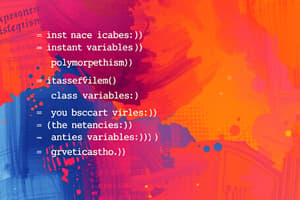Podcast
Questions and Answers
What is the primary purpose of declaring an instance variable as private?
What is the primary purpose of declaring an instance variable as private?
- To ensure the variable can only be accessed within its own class. (correct)
- To allow direct access to the variable from any class.
- To make the variable constant and unchangeable.
- To optimize memory usage by the variable.
Which of the following best describes the concept of encapsulation in object-oriented programming?
Which of the following best describes the concept of encapsulation in object-oriented programming?
- Defining multiple classes with identical names and functionalities.
- Bundling data and the methods that operate on that data, and hiding internal details. (correct)
- Inheriting properties from a superclass.
- Creating multiple instances of the same class in memory.
In the context of object-oriented programming, what does an 'instance variable' represent?
In the context of object-oriented programming, what does an 'instance variable' represent?
- A global variable accessible to all classes.
- An attribute or property of an object. (correct)
- A class-level constant.
- A method that can only be called once.
Which of the following is a benefit of using instance variables?
Which of the following is a benefit of using instance variables?
What does the term 'refactoring' refer to in software development?
What does the term 'refactoring' refer to in software development?
What is the main goal of applying the DRY (Don't Repeat Yourself) principle in programming?
What is the main goal of applying the DRY (Don't Repeat Yourself) principle in programming?
Which of the following programming concepts allows a subclass to inherit attributes and behaviors from a superclass?
Which of the following programming concepts allows a subclass to inherit attributes and behaviors from a superclass?
What is the purpose of an access modifier in object-oriented programming?
What is the purpose of an access modifier in object-oriented programming?
Suppose you want to create a class Dog that inherits from a class Animal. Which attribute should be defined in the Animal class rather than the Dog class?
Suppose you want to create a class Dog that inherits from a class Animal. Which attribute should be defined in the Animal class rather than the Dog class?
When should you consider refactoring your code?
When should you consider refactoring your code?
What is the main purpose of declaring instance variables?
What is the main purpose of declaring instance variables?
When should you use a public access modifier for an instance variable?
When should you use a public access modifier for an instance variable?
What is the relationship between a class and an object?
What is the relationship between a class and an object?
What is a potential drawback of not adhering to the DRY principle?
What is a potential drawback of not adhering to the DRY principle?
Which of the following scenarios could benefit most from refactoring?
Which of the following scenarios could benefit most from refactoring?
In the context of inheritance, what is a 'superclass'?
In the context of inheritance, what is a 'superclass'?
Consider a class Car with a fuelLevel attribute that should only be modified by the methods within the Car class. Which access modifier should you use for fuelLevel?
Consider a class Car with a fuelLevel attribute that should only be modified by the methods within the Car class. Which access modifier should you use for fuelLevel?
You notice that you have several methods across different classes performing similar calculations. Which principle would suggest creating a common utility function to avoid repetition?
You notice that you have several methods across different classes performing similar calculations. Which principle would suggest creating a common utility function to avoid repetition?
Why is encapsulation considered a key aspect of object-oriented programming?
Why is encapsulation considered a key aspect of object-oriented programming?
Which action is an example of 'refactoring' code?
Which action is an example of 'refactoring' code?
What does it mean if a variable has public access?
What does it mean if a variable has public access?
What is the main benefit of using inheritance in object-oriented programming?
What is the main benefit of using inheritance in object-oriented programming?
Which of the following data types can be assigned to an instance of the int value width?
Which of the following data types can be assigned to an instance of the int value width?
Regarding the DRY principle, what would be the BEST approach if the same algorithm needs to be applied in three different classes?
Regarding the DRY principle, what would be the BEST approach if the same algorithm needs to be applied in three different classes?
Which choice BEST demonstrates the use of encapsulation?
Which choice BEST demonstrates the use of encapsulation?
When considering object-oriented programming principles, which is the benefit of a class inheriting attributes from a superclass?
When considering object-oriented programming principles, which is the benefit of a class inheriting attributes from a superclass?
Regarding instance variables and attributes, how are attributes of an object represented in a class?
Regarding instance variables and attributes, how are attributes of an object represented in a class?
Which of the following best demonstrates the DRY principle?
Which of the following best demonstrates the DRY principle?
What does the term 'access modifier' refer to in object-oriented programming?
What does the term 'access modifier' refer to in object-oriented programming?
Which of the access modifiers provides the LEAST restrictive access?
Which of the access modifiers provides the LEAST restrictive access?
Which of the following is NOT an example of code refactoring?
Which of the following is NOT an example of code refactoring?
What is the benefit of using encapsulation within accessor and mutator (getter and setter) methods?
What is the benefit of using encapsulation within accessor and mutator (getter and setter) methods?
The following code has redundency. Which of the principles can be applied to improve the code?
`class Cake{
public String cake_type;
public String cake_flavor;
public Cake(String type,String flavor){
this.cake_type = type;
this.cake_flavor = flavor;
}
};
class Pastry{
public String pastry_type;
public String pastry_flavor;
public Pastry(String type,String flavor){
this.pastry_type = type;
this.pastry_flavor = flavor;
}
}`
The following code has redundency. Which of the principles can be applied to improve the code?
`class Cake{ public String cake_type; public String cake_flavor;
public Cake(String type,String flavor){
this.cake_type = type;
this.cake_flavor = flavor;
}
};
class Pastry{ public String pastry_type; public String pastry_flavor;
public Pastry(String type,String flavor){
this.pastry_type = type;
this.pastry_flavor = flavor;
}
}`
How does inheritance facilitate code reuse?
How does inheritance facilitate code reuse?
If a class named Vehicle has a private attribute to store the vehicle identification number (VIN), how can other classes get the VIN?
If a class named Vehicle has a private attribute to store the vehicle identification number (VIN), how can other classes get the VIN?
Which of the following is a valid reason to refactor code, even if it's functioning correctly?
Which of the following is a valid reason to refactor code, even if it's functioning correctly?
Which of the following demonstrates the declaration of a string instance variable?
Which of the following demonstrates the declaration of a string instance variable?
A developer needs to modify a class originally written by someone else. To ensure the changes do not affect other parts of the system, what should the developer focus on when refactoring?
A developer needs to modify a class originally written by someone else. To ensure the changes do not affect other parts of the system, what should the developer focus on when refactoring?
Consider two classes: Bird and Penguin. Bird has a method fly(). Penguin is a subclass of Bird, but penguins cannot fly. What does this scenario illustrate?
Consider two classes: Bird and Penguin. Bird has a method fly(). Penguin is a subclass of Bird, but penguins cannot fly. What does this scenario illustrate?
In a class diagram, what does an arrow pointing from class A to class B typically represent?
In a class diagram, what does an arrow pointing from class A to class B typically represent?
Flashcards
Attributes
Attributes
Characteristics of the object.
Public
Public
Visible to all classes in a program.
Private
Private
Visible only inside the class.
Class
Class
Signup and view all the flashcards
Object
Object
Signup and view all the flashcards
Instance variable
Instance variable
Signup and view all the flashcards
Access modifier
Access modifier
Signup and view all the flashcards
Encapsulation
Encapsulation
Signup and view all the flashcards
Inheritance
Inheritance
Signup and view all the flashcards
Refactor
Refactor
Signup and view all the flashcards
DRY principle
DRY principle
Signup and view all the flashcards
Study Notes
Lesson Objectives
- Differentiate between public and private access
- Declare instance variables to represent attributes of an object
- Refactor code to create class hierarchies with shared attributes
Core Concepts
- In Java, a class is a programmer-defined blueprint from which objects are created
- An object is an instance of a class
- When an object is instantiated, it gets its own copy of the instance variables
Instance variables
- An instance variable is a variable defined in a class that represents an attribute of an object
- Common data types for instance variables include:
boolean: true or falseint: whole numbers, like 7 or 6784double: decimal numbers, like 2.5 or 92.81String: a sequence of characters, like "purple"
Declaring Instance Variables
- Instance variables can be declared with the format
private int xLocation; - The
privatekeyword sets the access of the instance variable to private, making it only accessible from inside the class - The
intkeyword defines the data type for the instance variable - The
xLocationnames the instance variable
Inheritance
- Inheritance is an object-oriented programming principle where a subclass inherits the attributes and behaviors of a superclass
Encapsulation
- Encapsulation is an object-oriented programming concept where the instance variables of a class are hidden from other classes and can be accessed only through the methods of the class
- The visibility of classes, variables, constructors, and methods can be set by using an access modifier
public: visible to all classes in a programprivate: visible to only inside the class
Refactoring
- Refactoring code improves the readability, reusability, or structure of program code without altering its functionality
- The DRY (Don't Repeat Yourself) principle is a software development guideline to reduce repetition in code
Key vocabulary
- Instance variable: a variable defined in a class that represents an attribute of an object
- Access modifier: a keyword used to set the visibility of classes, variables, constructors, and methods
- Encapsulation: an object-oriented programming concept where the instance variables of a class are hidden from other classes and can be accessed only through the methods of the class
- Refactor: to improve the readability, reusability, or structure of program code without altering its functionality
- DRY principle: a software development principle that stands for "Don't Repeat Yourself" which aims to reduce repetition in code
Studying That Suits You
Use AI to generate personalized quizzes and flashcards to suit your learning preferences.




